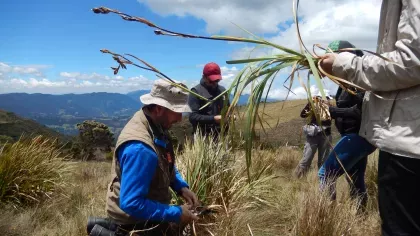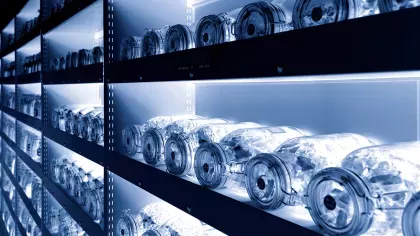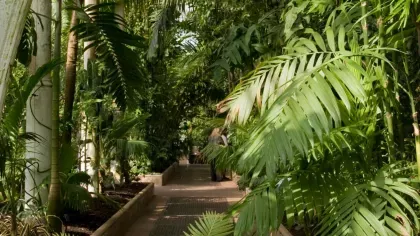Boyacá Seed Bank
Building expertise and capacity for conservation seed-banking in Colombia, with the initial focus on Boyacá flora within the Páramo biome.

Background
Colombia is known to be one of the most biodiverse countries in the world. Nevertheless, the current knowledge on inventory and monitoring of biodiversity and ecosystems does not fully reflect this richness, being incomplete in certain regions. Counteracting this situation, the nation-wide ‘Colombia Bio’ programme has recently been established by the Colombian government with the main aim of making sustainable economic use of Colombia’s biodiversity resources. This programme offers a unique opportunity for Kew and partner organisations in Colombia to undertake primary research on biodiversity and ecosystem services in parts of the country as yet completely unexplored. The ambition of this exploratory research is to enable long-term plans for the conservation and sustainable use of Colombia’s natural capital to be established.
Kew Science will be involved in a significant number of research projects over the next 4-5 years (from 2017) under the umbrella of the Colombia Bio programme.
This particular project is designed to establish expertise and capacity for conservation seed-banking of Boyacá flora, focused on the Páramo biome.
The need for seed banking
Within 74 natural ecosystems recognised by the Colombian Information System for Biodiversity (SIB), the 22,000 plants in Colombian flora place the country in second place globally for plant diversity, although it is estimated that 798 plant species are currently threatened. The flora of the páramo habitat has become a particular priority for conservation due to the high level of endemism, habitat loss due to agriculture and mining, and concerns over the impact of climate change on this fragile ecosystem. However, the specimen data available from herbaria within SIB suggest that Boyacá’s biodiversity has been under-recorded with regard to geo-referenced specimens. In addition, no national or regional seed bank exists for wild plants to provide secure ex situ conservation of genetic diversity from priority threatened, endemic and useful species, and to support the developing bioeconomy.
Predictions from research are that seeds from 80% of Colombian flora will tolerate drying, enabling seed banking as a viable conservation strategy. Kew is therefore initiating a seed bank project in Boyacá.
By using well established capacity-building techniques, Kew scientists will advise and assist IAVH and UTPC counterparts in Colombia to establish expertise and capacity for conservation seed-banking of Boyacá flora, focused on the Páramo biome.
Over 8 months from July 2017 this project will:
- Develop scientific expertise in the collection, conservation, and evaluation of seeds from priority wild flora of Boyacá;
- Strengthen capacity of national facilities to evaluate and store seed collections according to international standards; and
- Collect and preserve seed accessions of 50 priority species from the 2017-2018 expedition programme as a pilot for expansion.
Objectives
The overall aim is to strengthen Colombia’s capacity to collect, assess and legitimately exploit its plant genetic resources to support its developing Bio-economy. This project will initially focus on establishing expertise and capacity for conservation seed-banking of Boyacá flora, focussed on the Páramo biome.
Project Leader
The main deliverables of the seed bank project will be capacity building in terms of training and provision of facilities and in ex-situ conservation, and are detailed below:
Capacity Building: Training
To develop scientific expertise in the collection, conservation, and evaluation of seeds from priority wild flora of Boyacá
- Joint desk study of potential for conventional seed storage of flora from Boyacá
- Seed Conservation Techniques course (approx. 15 participants, 5 days) to be held for delegates selected by IAVH & UPTC
- Published Seed Collecting field manual, co-edited by Kew and IAVH
Capacity building: Facilities
To strengthen capacity of national facilities to evaluate and store seed collections according to international standards
- Technical assessment and report on options for enhanced seed storage facilities at IAVH and/or UPTC
- Engagement of existing crop seed banks including at CIAT in order to facilitate cooperation on standards, technology transfer, and research
- Low-cost seed drying and seed storage solutions provided and installed at IAVH and/or UPTC
Ex situ Conservation
To collect and preserve seed accessions of 50 priority species from the 2017-2018 expedition programme as a pilot for expansion across the entire programme
- Kew botanists participate in existing expedition programme to contribute seed expertise.
- Seeds of initially 50 species collected from the expeditions programme in páramos, transferred to seed banks for conservation and research
- Evaluation of the seed collecting component of expeditions published to guide expansion of this activity in future projects
Wyse, S.V. & Dickie, J.B. (2017)
Predicting the global incidence of seed desiccation sensitivity
Journal of Ecology
Martens, E., Way, M. & Wyse, S. (2017)
The potential role for seed banking as a conservation tool for the flora of Colombia
Poster presentation for IX Congreso Colombiano de Botánica, 30th July - 3rd August 2017, Tunja, Boyacá
Films
Seed collecting expedition to the Atacama desert, Chile ‘The blooming desert’
Ecotourism: Colombia's next big destination
Articles
Collecting Seed from Tropical Dry Forests of Colombia [in Spanish]


